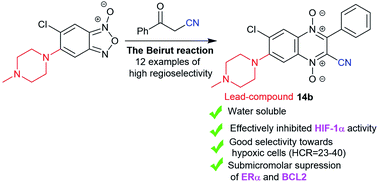Synthesis of 7-amino-6-halogeno-3-phenylquinoxaline-2-carbonitrile 1,4-dioxides: a way forward for targeting hypoxia and drug resistance of cancer cells†
Abstract
To establish a new approach for the synthesis of quinoxaline 1,4-dioxides as hypoxia-selective cytotoxic agents, an original multi-step preparation of derivatives possessing the diamine moiety at position 7 was evaluated. Herein, we present the synthesis of a series of novel 7-amino-6-halogeno-3-phenylquinoxaline-2-carbonitrile 1,4-dioxides 13a–h, 14a,b,g based on the regioselective Beirut reaction. Comparison of antitumor properties of derivatives possessing the diamine moiety at position 7 with structurally close congeners possessing the corresponding amino groups at position 6 revealed key differences in the cytotoxicity profiles and HIF-1α inhibition. All the synthesized 7-amino-6-halogeno derivatives 13a–h, 14a,b,g demonstrated significant cytotoxic activities against breast cancer cell lines (MCF7, MDA-MB-231) in normoxia and hypoxia with IC50 values ranging from 0.1 to 7.6 μM. Most of these novel derivatives can circumvent the multidrug resistance of tumor cells caused by P-glycoprotein over expression. The lead compounds 13a, 14a and 14b can suppress the expression of HIF-1α at low micromolar concentrations and induce apoptosis in breast cancer MCF7 cells. In addition, compound 14b effectively inhibits BCL2 and ERα expression in MCF7 cells. The current research opens a new direction for targeting hypoxia and drug resistance of cancer cells.



 Please wait while we load your content...
Please wait while we load your content...